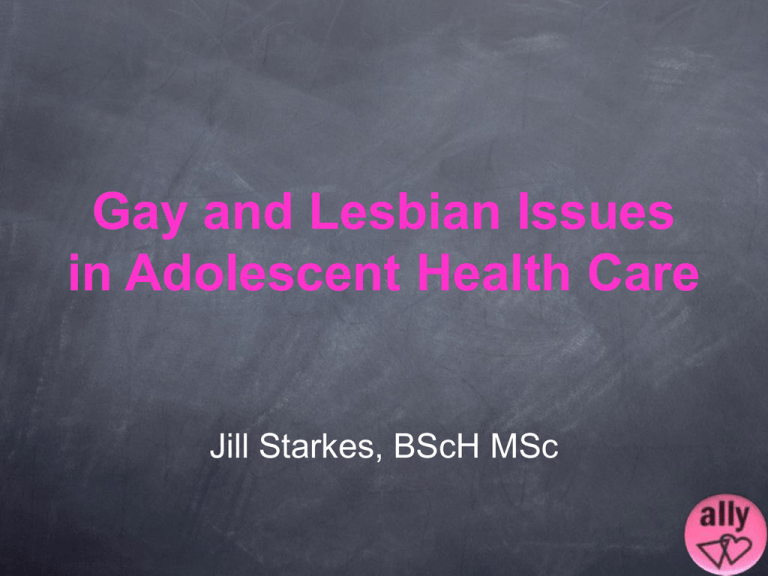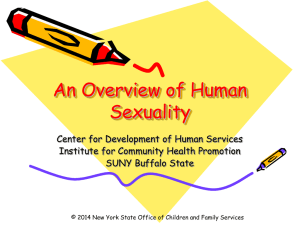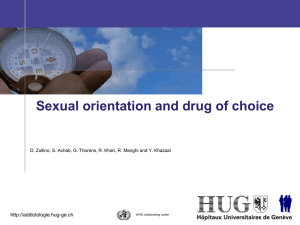
Gay and Lesbian Issues
in Adolescent Health Care
Jill Starkes, BScH MSc
Heterocentrism
• The default assumption that everyone is
heterosexual until proven otherwise
• Can erroneous conclusions and insensitive
remarks
• Adolescents quickly pick up on subtle messages
– Non-inclusive language
– Office information (posters, brochures, etc.) that is not
gender-neutral
Terminology
•
How do we know a patient is “gay”?
– Young person adopts and articulates to
others a SEXUAL IDENTITY LABEL?
– Same-sex behaviour has occurred?
•
NEITHER necessarily implies SEXUAL
ORIENTATION
Terminology
• SEXUAL ORIENTATION = pattern of
physical and emotional attractions to
others
• SEXUAL BEHAVIOUR = the sexual
activities in which individuals engage
• Sexual partners may or may not be
consistent with a young person’s
underlying orientation
Behaviour ≠ orientation
• Cultural and individual factors may
modify behaviour
– Religiosity
– Family values
– Race
– Ethnicity
– Gender
– Age
Terminology
• SEXUAL IDENTITY: a socially recognized label
that names sexual feelings, attractions, and
behaviours
– “I am gay”, “I am straight”, etc.
– Limited by the number of socially constructed
identities
– Inclusion of LGBTQQ, two-spirited
• Recent move towards rejecting reductionistic
definitions
– “I love Susan”, “I am unlabelled”
Sexual domain inconsistency
• Very common in adolescents who are just
beginning to explore their sexuality
• Consider the example of a young girl who:
– Is attracted to both sexes (bisexual sexual orientation)
– Chooses to have sex only with women (lesbian
behaviour)
– Identifies as heterosexual to ease parental concerns
• How do you ask about sexuality?
Perrin 2004
“Are you interested in men, women, or
both?”
“Are you sexually active with men,
women, or both? What does ‘sexually
active’ mean to you?”
“What do you consider your sexual
orientation?”
• Ask these questions again at a later date,
as answers to the above may change with
time
Will teens disclose their sexual
orientation?
• Low rates of disclosure to health care providers
among LGB adolescents and adults
– In a sample of teens who were “out”, only 35% had
disclosed this to a physician
• Barriers to disclosure:
–
–
–
–
Privacy and confidentiality concerns
Parent in the exam room
Teens too embarrassed too bring it up
½ the time, physicians haven’t asked
• Most teens who disclosed their orientation felt
that their health care improved afterward
Meckler 2006
Why is important to know if a teen
patient is LGB?
• Sexuality is an important part of any
adolescent’s life
• LGB teens have unique medical and
psychosocial needs
– Growing body of research suggests
increased risk of behaviours that threaten
health in this population
Development of gay identity
IDENTITY
confusion comparison tolerance acceptance pride synthesis
• Our goal is to support normal adolescent
development
• Teens whose environments are critical of their
emerging orientation may fail to achieve
developmental goals related to self-esteem,
identity and intimacy
LGB health risk: why?
• MINORITY STRESS MODEL
– Health disparities explained mostly by stressors
induced by a “hostile, homophobic culture”
lifetimes of harassment, discrimination and
victimization
• Normal stressors of puberty compounded
exponentially by the additional stress of being
gay
• Discrimination in other areas of gay teens’ lives
may expectation of similar treatment in the
healthcare system
Meyer 2003
Why don’t we have more evidence
about LGB teens to inform practice?
• Methodological issues in studying a
“hidden population”
– Defining the population of interest (as
discussed previously)
– Recruitment mechanisms (ie. schoolbased samples vs. homeless youth)
– Youth and research ethics boards
Substance use
• High rates of substance use and abuse among LGB
adults
– ↑ rates may have their origins in adolescence
• Homosexual youth more likely to use substances than
heterosexual youth
– Effects sizes largest for cigarettes and hard drugs
• OR = 4.23 for lifetime use of cigarettes
• OR= 3.09 for cocaine
• OR = 7.23 for IV drug use
– Not much evidence about substance use disorders
– Reported ↑ in the use of “designer” or “club” drugs, esp. by
young gay men
Marshall 2008
Suicide
• LGB youth report ↑ rates of suicidal
ideation and suicide attempts compared to
heterosexual youth
– 17.2% of LGB youth aged 18-26 had thought
about suicide; 6.3% of non-LGB youth
– Problem drinking and depression ↑ risk for
suicidal ideation, but not attempts, in this
population
Silenzio 2007 (NLSAH)
Eating-disordered behaviour
• Sexual orientation is an important factor in risk
for weight concerns and ED behaviours
• Gay and bisexual boys make more effort to look
like boys/men in the media
– More likely to have binged
– Adult G/B men more likely to have weight concerns,
practice dietary restraint
• Lesbian and bisexual girls reported ↑ body
satisfaction compared to heterosexual girls
– Similar findings among adult L/B women
Austin 2004 (GUTS)
Sexually transmitted infection
• Particular BEHAVIOURS, not sexual
ORIENTATION, determine risk for STIs
• Personal risk factors for STIs (including HIV)
among MSM:
– Inconsistent use of condoms during anal sex (40% of
young MSM report unprotected sex in the last 6
months)
– Substance abuse
– Lack of communication with partners
• ↑ risk also associated with dual-gender sexual
activity
Benson 2005
Sexually transmitted infection
• GLB teens less likely to pursue STI
screening and treatment
– ↑ concerns about confidentiality and/or being
judged for their orientation compared to other
teens
– Sexual health clinics specific to the GLB
community are rare
– Heterocentric clinics may not have
appropriate rectal or pharyngeal swabs to
screen for G/C
Benson 2005
Sexually transmitted infection
• Very limited data about STIs among gay
teens exists
– Numerous measurement issues arise, esp.
the definition of orientation among teens who
are still exploring their sexuality
• Lack of research is a major obstacle to
health promotion activities for this
population
Sexual orientation violence
• LGB youth report high levels of victimization at
school (verbal harassment physical abuse)
– 10% of girls and 24% of boys, vs. 1% and 3% of nongay teens
– Truancy due to safety concerns
– Abandonment of educational goals
– Victimization may be related to gender atypicality
• LGB youth who are victimized report high levels
of substance use, suicidality, and sexual-risk
behaviours
Bontempo 2002
Culturally competent healthcare for
GLB teens
• Assure confidentiality
– Encourages honest discourse and seeking
help when it is required
– Supports autonomy and responsibility as the
teen transitions to adulthood
• Take a comprehensive sexual history
– Focus on behaviour-based risk assessment
– Don’t make assumptions about gender of
sexual partners or relationship status
Culturally competent healthcare for
GLB teens
• Remember that there may be a
discrepancy between same-sex
behaviour and self-identification as
LGB
• Ask about mood, substance use,
ED behaviours
– “I ask all teens these questions…”
– Don’t forget questions about bullying and
victimization
Culturally competent healthcare for
GLB teens
• Despite the many challenges they face, many LGB teens
develop and possess remarkable strength and
determination
• Ultimate goal is to create a comfortable
environment in which LGB youth may
seek help and support for appropriate
medical care
• Assist in the transition to the adult health care system,
where LGB people have traditionally been
underrepresented
References
•
•
•
•
•
•
•
•
•
•
Sexual orientation and adolescent substance use: a meta-analysis and
methodological review. Addiction. 2008 Apr;103(4):546-56.
Sexual orientation and risk factors for suicidal ideation and suicide attempts
among adolescents and young adults. Am J Public Health. 2007
Nov;97(11):2017-9.
Nondisclosure of sexual orientation to a physician among a sample of gay,
lesbian, and bisexual youth. Arch Pediatr Adolesc Med. 2006 Dec;160(12):124854.
Bacterial sexually transmitted infections in gay, lesbian, and bisexual
adolescents: medical and public health perspectives. Semin Pediatr Infect Dis.
2005 Jul;16(3):181-91.
Gay and lesbian issues in pediatric health care. Curr Probl Pediatr Adolesc
Health Care. 2004 Nov-Dec;34(10):355-98.
Sexual orientation, weight concerns, and eating-disordered behaviors in
adolescent girls and boys. J Am Acad Child Adolesc Psychiatry. 2004
Sep;43(9):1115-23.
Sexual orientation and adolescents. Pediatrics. 2004 Jun;113(6):1827-32.
Not all adolescents are the same: addressing the unique needs of gay and
bisexual male youth.Adolesc Med. 2003 Oct;14(3):595-611, vi.
Effects of at-school victimization and sexual orientation on lesbian, gay, or
bisexual youths' health risk behavior. J Adolesc Health. 2002 May;30(5):364-74.
Health care issues of gay and lesbian youth. Curr Opin Pediatr. 2001
Aug;13(4):298-302.









